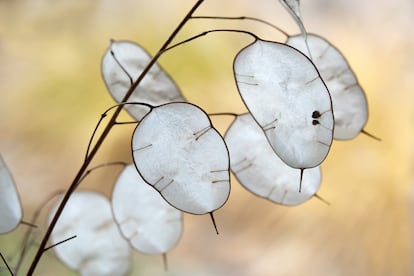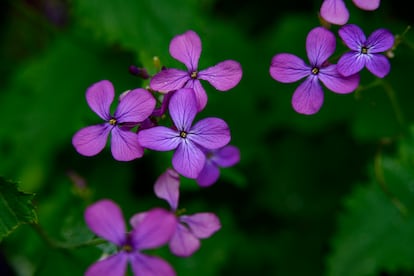The brilliant maturity of ‘annual honesty,’ the plant that rustles in the wind and gets prettier as it ages
Popularly known as honesty, silver moonplant, money-in-both-pockets, silver dollar, or Chinese coins due to the resplendent halo of its dried pods, the humble ‘Lunaria annua’ reveals its most evocative nature just before dying

One of the most revealing lessons that can be learned from plants in particular and nature in general is to appreciate the uniqueness and charm of each part of the life cycle. This is especially evident in flowering plants: they tend to amaze us in their youth, when they sprout, bloom, and exhibit their maximum lushness. We admire them, give them as gifts and photograph them when they are in their privileged and ephemeral prime, before reaching maturity. And then, what…?
A minimum of sensitivity — botanical or simply artistic — is enough to feel moved by the dry sphere of an allium, by the golden skeleton of a hydrangea at the beginning of winter, by the lean and dehydrated structure of a withered reed, or by the parched ears of cereal. And we are not talking about plants that are artificially dried by a florist; we are talking about species that are still alive, rooted in the same soil where they have sprouted and grown: old plants just at the moment before breathing their last.
The Lunaria annua is one of the most poetic examples of plant species that display their most seductive attributes just before dying. “Pale dusted like / the Luna’s wings / I’d like to meet / October’s chill. / Like the silver moonplant/ Honesty, / that bears toward winter/ its dark seeds.” These verses belong to the poem Lunaria written by the American poet and essayist Katha Pollitt. “I was inspired by the idea of the lunaria evolving through the different stages of its life until the last, which is also the most striking and unusual. This aging is not only a loss, but a stripping away of the inessential,” Pollitt wrote about the emotions that contemplating the life cycle of the Lunaria annua, with its fascinating metamorphoses transmitted to her, and that finally encouraged her to write about it.
And this humble plant with undemanding habits (it grows in areas of rubble, on the verges of roads and paths and on damp, shady slopes, although also in semi-shade) is the ugly duckling of the perennials. Its purple flowers are simple and discreet. But the true rarity of the lunaria, what makes it attractive and special, reveals itself in the plant’s old age. Once the flowers fall and their fruit has lost its greenness, when the shrub has already taken the path of no return towards the end of its days.
The youth of the lunaria, in spring, is perhaps its most unremarkable stage. Starting in March, this annual or biannual perennial with large toothed leaves blooms with clusters of small, four-petaled flowers. There are different cultivars with white, pink, magenta, and even variegated flowers, although the most common have purple flowers.

As an adult plant, around the month of June, the spicules appear — disc-shaped capsules that will contain the seeds. It is these pods that transform the ugly duckling into a swan in the fall. When they mature, the pods dry and the very thin skin that covers the seeds on both sides of the capsule detaches to release them and self-seed. Then a translucent, shiny, pearly-looking central membrane is revealed, which is what gives this plant all its names: money plant, moneywort, penny flower, silver dollar, money-in-both-pockets, Chinese money, or Chinese coins... As Katha Pollitt’s poem says, it is also called honesty, because the membrane of the lunaria sheath is so translucent it is incapable of hiding anything.
It is in that bright and silvery stage of old age when the Lunaria annua displays all its charms to the full. Not only does it sparkle, it also murmurs. The stiff silvery pods rustle like a tissue paper cradled by the warm wind of late summer.

A lantern in autumn
In the Victorian era, attracted by the romantic and gothic halo of the dried bunches of Lunaria annua, miniaturists painted detailed scenes with Indian ink on the silver membrane of its pods. The artworks were very much in the Anglo-Japanese taste that became fashionable in Europe at the end of the 19th century. Decorative artists were inspired by crafts with washi paper, a delicate but resistant material with a polished finish used for millennia in Japan not only as a material for calligraphy and painting, but also for making votive pendants, umbrellas, courtesy cards, dolls, hand fans, and so on. “The traditional shōji are also made with washi, the wooden panels and translucent paper that filter the light towards the interior of homes and that are so loved in Japan because they satisfy that desire to feel the presence of nature indirectly,” the Nippon portal explains. “And the portable lanterns and torches that illuminate the darkness of the night with soft, diffuse light,” they add.
Just like the Lunaria annua, more beautiful than ever in autumn, at the end of its days, according to Katha Pollitt: “A paper lantern / lit within / and shining in / the fallen leaves.”
Sign up for our weekly newsletter to get more English-language news coverage from EL PAÍS USA Edition









































